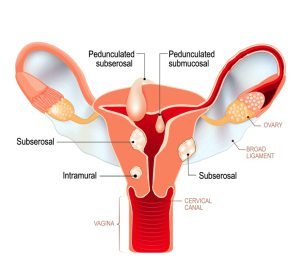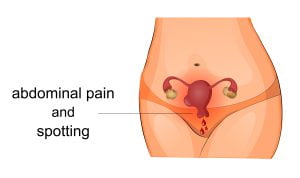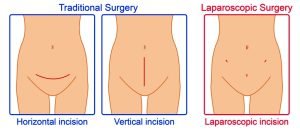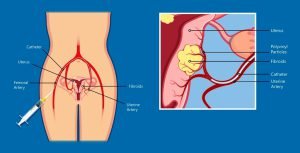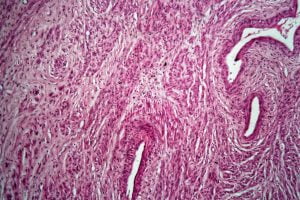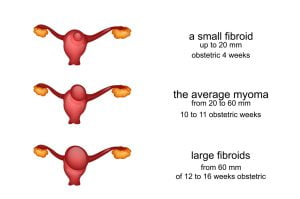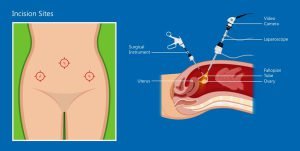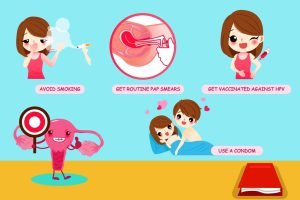Browsing: Uterine Fibroids Graphics
Comprehensive Information, Resources, and Support on Uterine Fibroids
Uterine fibroids are classified by their location (see in the figure), which defines the symptoms they may cause and how they can be treated. Intramural fibroids are the most common and grow in the wall of the uterus. Subserosal fibroids grow on the outside of the uterus. Submucosal fibroids grow underneath the uterine lining and can develop into the uterus cavity and lead to heavy bleeding and other serious complications.
Uterine fibroids range in size from seedlings to bulky masses which lead to enlargement or distortion of the uterus. Uterine fibroids often become large and cause severe abdominal pain and heavy periods. Common surgical treatments for uterine fibroids are endometrial ablation, myomectomy, hysterectomy, etc. Surgery depends on the size of fibroids, number of fibroids, location and chances of acquiring pregnancy, etc. In case of abdominal myomectomy, fibroids are removed by an incision in the abdomen. In a laparoscopic surgery, small cuts are made to remove the fibroid. Hysterectomy is a major surgery in which larger vertical incision is made in the belly.
Uterine Fibroid Embolization (UFE) is a minimally invasive treatment or a non surgical way to treat fibroids by blocking the blood flow through the arteries (that feed the fibroids) which shrinks the fibroids. Uterine artery embolization is another name of uterine fibroids embolisation. Uterine fibroids are non-cancerous lumps which grow on the uterus and leads to pregnancy related complications. Uterine fibroid embolization destroys fibroid tissue and removes fibroids. During UFE, a 1/4-inch-long cut in the skin is made and a catheter (a thin tube) is inserted into the femoral artery. The catheter is threaded into the uterine artery (supplies blood to the uterus). Gelatin particles are injected through the catheter into the blood vessels and block the blood supply that carries blood to the fibroids. This causes fibroids to shrink
Cells of a human uterus with uterine fibroids under the microscope. Research studies revealed that connective tissue made by the cells in uterine fibroids is markedly abnormal and this abnormality may contribute to fibroid growth. Although currently available treatment options can control uterine fibroid symptoms and can shrink them, but only hysterectomy eliminates them completely.
Fibroids can vary in number and size from a single growth to multiple growths, and from very small to very large. A very large uterine fibroid can expand the uterus to the size of a 6 or 7 month pregnancy. Fibroids can develop as a single dominant fibroid or as a group of many small fibroids. As many as 80% of all women have fibroids by age 50.
A laparoscopic hysterectomy is a minimally invasive surgical procedure to remove the uterus. During a laparoscopic hysterectomy, a small incision is made in the navel and a tiny camera is inserted. Camera provides an image on a TV monitor which makes the procedure easier. Then, two to three other tiny incisions are made in the lower abdomen and specialized instruments are inserted. This helps in the removal process. If the uterus is removed, women cannot get pregnant. Uterine fibroids almost never grow back after hysterectomy. It is rare that fibroids will grow near the uterus after hysterectomy.
Uterus is a hollow muscular organ located in the female pelvis between the bladder and the rectum. Its function is to keep and nourish the fetus till its birth. Heavy bleeding during periods or after sex is a common sign of unhealthy uterus. Hormone imbalance, thyroid problems, infection, or pregnancy are some causes of uterine disorders. Common uterine problems are uterine fibroids, endometriosis, uterine prolapsed, uterine tuberculosis, etc. Some common tips to maintain uterine health is avoiding birth control pills, quitting smoking, doing exercise and maintaining healthy body weight, increased consumption of vitamin C and fiber, avoiding xenoestrogens, keeping clean, avoiding multiple sexual partners, etc.
ADVERTISEMENT




